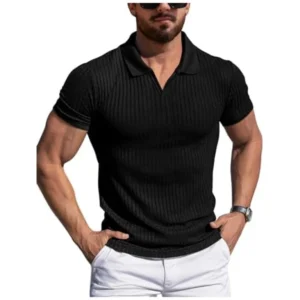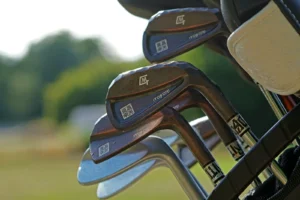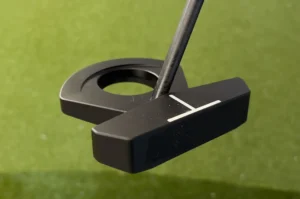Golf may seem like a leisurely game, but a powerful golf swing requires a finely tuned balance of flexibility, stability, and strength through the entire body with Golf muscles used in swing. Understanding which muscle groups generate speed and prevent injury during the swing can help you maximize your driving distance and accuracy.
Proper strength training and conditioning of the legs, core, back, chest, and shoulders transfers to more power and control on the course. By targeting your workouts to train the primary movers involved in the backswing, downswing, and follow-through, you can add yards to your drives and maintain a healthy body that withstands the mechanics of an aggressive swing.
This guide will break down the key muscles used at each phase of the golf swing so you can create the ideal fitness routine to unleash your full potential.
Golf muscles used in Swing
Backswing Muscles – Loading Up for Power
The backswing sets the stage for an explosive downswing by activating the muscles needed to load energy into the system. The upper body coils against resistance from the lower body to store power.
Upper Trapezius and Mid Trapezius
The upper trapezius muscles running along the upper back and neck initiate the takeaway by controlling the movement of the arms and shoulders. Keeping the upper trapezius flexible allows for a full shoulder turn back.
The mid trapezius assists with raising the arms and stabilizing the shoulder blade during the backswing. Strengthening this area prevents injury and strains for an chip shot.
Exercises: Face pulls, upright rows, and mid-back flies
Subscapularis
This internal rotator muscle attaches the shoulder blade to the humerus. It externally rotates the arm on the backswing and controls the transition into internal rotation on the downswing.
Imbalances between the subscapularis and other shoulder muscles can lead to injury over time. Train it evenly with the rest of the rotator cuff.
Exercises: Internal and external rotation exercises with resistance bands or cables
Biceps Femoris
The biceps femoris muscle in the back of the thigh controls hip extension and external rotation in the trail leg. Keeping this area flexible allows for a bigger hip turn on the backswing.
Tight hamstrings will restrict the backswing and cause overuse of the lower back muscles.
Exercises: Hamstring stretches, Romanian deadlifts
Obliques and Abdominals
Rotation of the core muscles initiates the backswing and controls the amount of turn. The obliques and abdominals work isometrically to resist over-rotation.
Strong obliques stabilize the hips during the coil while the abdominals flex to resist excessive arching of the lower back.
Exercises: Russian twists, pallof presses, planks
Downswing Muscles – Generating Speed and Power
The downswing rapidly unwinds the loaded backswing into an explosive release of stored power. Your glutes, chest, and upper back provide most of the acceleration through impact.
Glutes
Your lead glute max muscle powers hip rotation to drive the downswing. The trail glute max controls hip extension to prevent sliding.
Together, they stabilize the pelvis and generate torque for lower body speed. Weak glutes reduce stability and hamper a forceful transition into the downswing.
Exercises: Squats, lunges, hip thrusts, kettlebell swings
Chest and Upper Back
As you rapidly rotate through impact, the chest accelerates arm movement while the upper back provides a stable base.
Pectoral strength brings the club down quickly into a squared impact position. Latissimus dorsi activation pulls the arms and club through the ball.
Exercises: Bench press, push ups, rows, lat pulldowns
Rotational power comes from the sequential firing of muscles from the ground up. Training your legs, core, and upper body together will maximize speed and distance.
Other Areas to Train for a Complete Golf Fitness Program
Beyond the major swing muscles, strengthening your shoulders, forearms, hands, and improving flexibility also enhances performance.
Shoulders
The rotator cuff muscles protect the shoulder joint during the golf swing. Strengthening the external rotators like the infraspinatus prevents injury.
Improving internal rotation flexibility allows for a fuller backswing and follow-through.
Exercises: Face pulls, external rotation exercises, sleeper stretch
Read Also; How to stop hitting duck hook in Golf
Forearms and Hands
A strong grip comes from forearm and hand strength. Wrist flexors help hinge the club, while extensors provide stability.
Building forearm muscle protects elbow joints from the forces of an aggressive swing.
Exercises: Wrist curls, reverse wrist curls, tennis ball squeezes
Flexibility
Maintaining mobility in your torso, hips, and shoulders enables a smooth, loose golf swing. The backswing and follow-through require ample flexibility to swing freely.
Stretching the muscles trained during workouts prevents imbalances and tightness. Yoga is great for golf flexibility.
Exercises: Thoracic rotations, hip flexor stretches, shoulder stretches
Creating a Golf Workout Routine
To get the most out of your training, follow a golf-specific program 2-3 times per week centered around strengthening the swing’s key muscles. Here is a sample weekly plan:
Monday Lower Body
Squats 5×5
Deadlifts 3×8
Lunges 3×10
Hamstring curls 3×12
Wednesday Upper Body
Bench press 5×5
Bent over rows 3×8
Shoulder press 3×10
Lat pulldowns 3×12
Friday Full Body Golf Focus
Romanian deadlifts 3×8
Single arm cable rows 3×10
Shoulder external rotations 3×12
Planks 3×30 seconds
Thoracic rotations 2×10
Balance heavy compound lifts that boost power with higher rep isolation exercises for muscular endurance. Include flexibility training like yoga on off days or after workouts.
Proper Recovery and Nutrition for Golf Fitness Gains
Supporting your golf strength training with proper recovery and nutrition maximizes results. Here are some tips:
Always stretch and foam roll after workouts to increase flexibility.
Hydrate before, during, and after exercise to prevent muscle cramps.
Consume 20-40g of protein within 30 minutes after training for muscle repair.
Eat carbohydrates to fuel intense training and provide energy.
Get 7-9 hours of sleep per night to allow muscles time to regenerate.
A purposeful golf workout program centered on the swing’s key muscles will unlock new levels of power and consistency while keeping you healthy. Properly training your legs, core, back, chest, and shoulders transfers to increased clubhead speed and lower scores on the course.
Use this guide on the main muscles used during the golf swing to develop a tailored routine that prevents injury, adds yards to your drives, and improves all aspects of your game.








